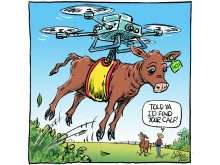Food versus fuel: it’s a phrase that often sparks debates, especially when energy prices rise.
The current case of pricey power is partially war fueled and partially part of recovery from the ongoing COVID economic slump. Biofuel, the basis of food versus fuel debates, is also assessed through its relationship with greenhouse gas production.
Wind, sun, wave, water and geothermal energy are nearly infinitely renewable. Nuclear energy is nearly as sustainable though it is a less popular option among many.
But all Earth’s natural sources of energy come at a cost and price discovery is based on whatever we can get for fossil or crop-based fuels. The latter is becoming more important as the former becomes increasingly expensive.
Read Also

Worrisome drop in grain prices
Prices had been softening for most of the previous month, but heading into the Labour Day long weekend, the price drops were startling.
Western Canada’s recent spate of oilseed crushing development isn’t intended to meet a demand for food oils. It’s purely an energy play. As a result, it will remove acres from food production and place them firmly in the portable power category, fueling diesel and aviation needs.
Crops used to produce biofuel are vital to commodity price success and the sustainability of many commercial-scale farms. Fuel blending standards, like the ones the Americans are constantly tweaking with government-set ratios of fossil fuel and biofuel, keep millions of acres in the energy sector, rather than growing food. Without them, commodity prices for both cereals and oilseeds would suffer substantially.
For the past dozen years, nearly all American gasoline has been, more or less, 10 percent ethanol. Other than the COVID energy use slump, the United States has been using about five billion bushels of corn annually for fuel ethanol.
And while American farmers have been growing more bushels annually, about one-third of those bushels are converted to alcohol fuel and distillers grains for livestock feed. That’s approximately 29 million acres of the expected 89.5 million U.S. acres that will be planted to corn in 2022. As much as 42 percent of American soybean oil will make its way into fuel tanks in the transportation industry.
Crushed soybeans and processed corn do end up in livestock rations and a myriad of other things. One need only visit Decatur, Illinois, otherwise known as Soy City, to arrive at that understanding, but the acres wouldn’t be planted to those crops if it weren’t for bioenergy demand.
There is no free lunch when it comes to power production and under the pressure of rising food prices, the non-farming public might pay greater attention to the relationship between acres, energy and food. Producers will also need to remain aware of the subject because it is likely to be addressed in public policy.
Energy crops create changes to land use by virtue of supporting higher commodity prices. Overall, they may increase greenhouse gas emissions and put pressure on water resources, and in some vulnerable watersheds create nutrient runoff issues.
Biofuels, as crops, are subject to government subsidies and market interventions, such as mandated use, to make them competitive with fossil fuels.
These issues might add tinder to the food versus fuel acres debate, but producers need to remain aware that public opinion of food is generally higher than that for fuel. Will biofuel remain as attractive as it is today, given the various political, economic and cultural issues? For those staking their futures on it, the question merits careful appraisal.
Karen Briere, Bruce Dyck, Barb Glen and Mike Raine collaborate in the writing of Western Producer editorials.















